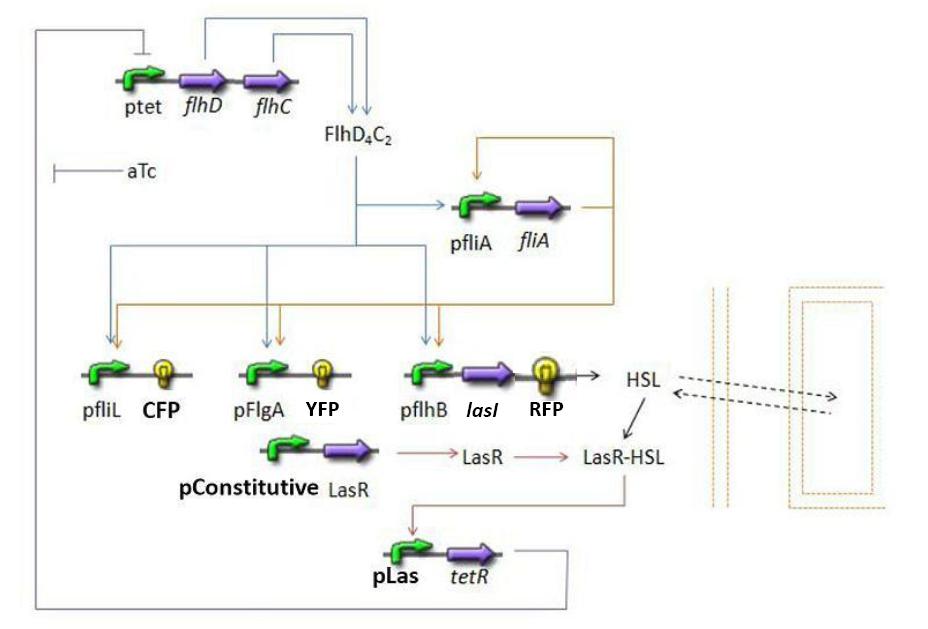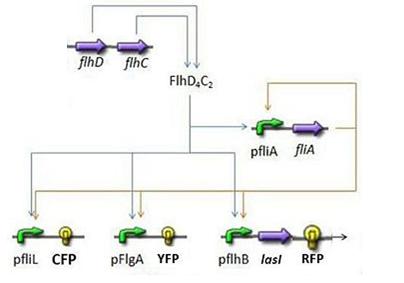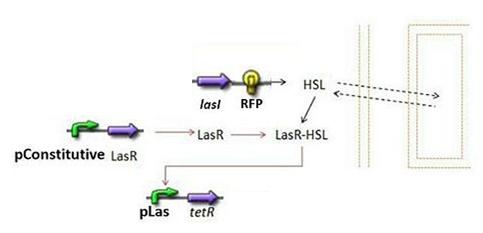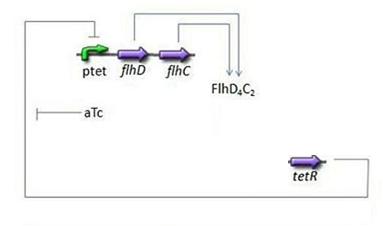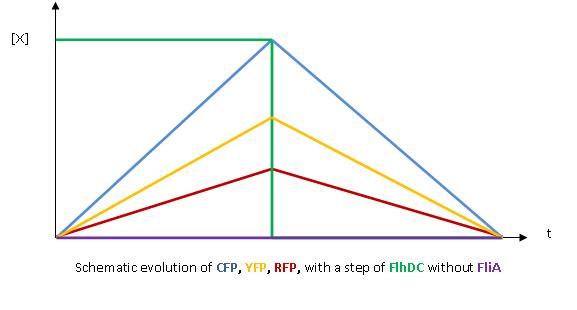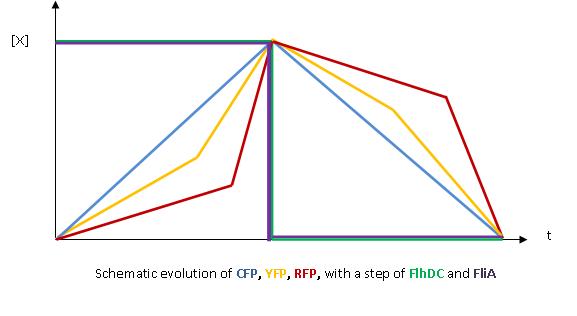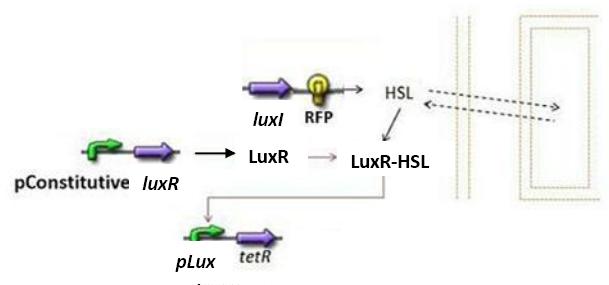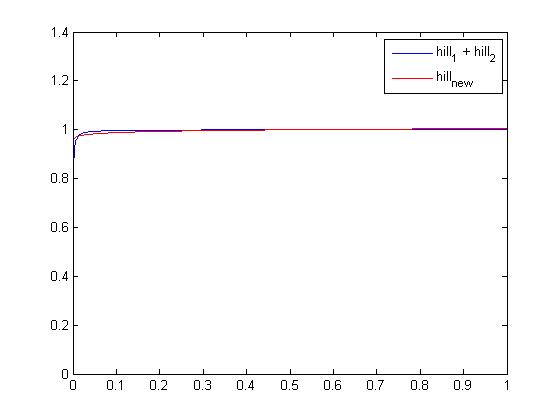Team:Paris/Modeling/BOB
From 2008.igem.org
(→Dynamics of HSL) |
(→Parameters Table) |
||
| Line 254: | Line 254: | ||
| Growth rate | | Growth rate | ||
| 0.0198 | | 0.0198 | ||
| - | | | + | | 1 |
| min<sup>-1</sup> | | min<sup>-1</sup> | ||
| [[Team:Paris/Modeling/BOB#Remarks|wet-lab]] | | [[Team:Paris/Modeling/BOB#Remarks|wet-lab]] | ||
| Line 261: | Line 261: | ||
| | | | ||
| Carrying capacity for cell growth | | Carrying capacity for cell growth | ||
| - | | | + | | 0.1 |
| - | | | + | | 0.1 |
| - | | | + | | µm<sup>3</sup> |
| [[Team:Paris/Modeling/BOB#Bibliography|[3]]] | | [[Team:Paris/Modeling/BOB#Bibliography|[3]]] | ||
|- style="background: #dddddd;" | |- style="background: #dddddd;" | ||
| Line 269: | Line 269: | ||
| | | | ||
| Dilution rate | | Dilution rate | ||
| - | | | + | | 0.00198 |
| - | | | + | | 0.1 |
| min<sup>-1</sup> | | min<sup>-1</sup> | ||
| [[Team:Paris/Modeling/BOB#Remarks|wet-lab]] ([[Team:Paris/Modeling/BOB#Bibliography|[3]]]) | | [[Team:Paris/Modeling/BOB#Remarks|wet-lab]] ([[Team:Paris/Modeling/BOB#Bibliography|[3]]]) | ||
| Line 277: | Line 277: | ||
| | | | ||
| Death rate | | Death rate | ||
| - | | 0. | + | | 0.0099 |
| - | | | + | | 0.5 |
| min<sup>-1</sup> | | min<sup>-1</sup> | ||
| [[Team:Paris/Modeling/BOB#Remarks|wet-lab]] | | [[Team:Paris/Modeling/BOB#Remarks|wet-lab]] | ||
|- style="background: #dddddd;" | |- style="background: #dddddd;" | ||
| - | | style="background: #D4E2EF;"|γ | + | | style="background: #D4E2EF;"|γ |
| | | | ||
| Degradation rate | | Degradation rate | ||
| Line 305: | Line 305: | ||
| min<sup>-1</sup> | | min<sup>-1</sup> | ||
| [[Team:Paris/Modeling/BOB#Bibliography|[1]]] | | [[Team:Paris/Modeling/BOB#Bibliography|[1]]] | ||
| - | |||
| - | |||
| - | |||
| - | |||
| - | |||
| - | |||
| - | |||
| - | |||
|- style="background: #dddddd;" | |- style="background: #dddddd;" | ||
| style="background: #D4E2EF;"|β<sub>CFP</sub> | | style="background: #D4E2EF;"|β<sub>CFP</sub> | ||
| Line 329: | Line 321: | ||
| min<sup>-1</sup> | | min<sup>-1</sup> | ||
| [[Team:Paris/Modeling/BOB#Bibliography|[1]]] | | [[Team:Paris/Modeling/BOB#Bibliography|[1]]] | ||
| - | |||
| - | |||
| - | |||
| - | |||
| - | |||
| - | |||
| - | |||
| - | |||
|- style="background: #dddddd;" | |- style="background: #dddddd;" | ||
| style="background: #D4E2EF;" |β<sub>YFP</sub> | | style="background: #D4E2EF;" |β<sub>YFP</sub> | ||
| Line 353: | Line 337: | ||
| min<sup>-1</sup> | | min<sup>-1</sup> | ||
| [[Team:Paris/Modeling/BOB#Bibliography|[1]]] | | [[Team:Paris/Modeling/BOB#Bibliography|[1]]] | ||
| - | |||
| - | |||
| - | |||
| - | |||
| - | |||
| - | |||
| - | |||
| - | |||
|- style="background: #dddddd;" | |- style="background: #dddddd;" | ||
| style="background: #D4E2EF;" |β<sub>RFP</sub> | | style="background: #D4E2EF;" |β<sub>RFP</sub> | ||
| Line 381: | Line 357: | ||
| | | | ||
| Degradation rate | | Degradation rate | ||
| - | | 0. | + | | 0.0053 |
| - | | | + | | 0.2690 |
| min<sup>-1</sup> | | min<sup>-1</sup> | ||
| [[Team:Paris/Modeling/BOB#Remarks|wet-lab]] | | [[Team:Paris/Modeling/BOB#Remarks|wet-lab]] | ||
| Line 389: | Line 365: | ||
| | | | ||
| Production rate | | Production rate | ||
| - | | 0. | + | | 0.3168 |
| - | | | + | | 16 |
| min<sup>-1</sup> | | min<sup>-1</sup> | ||
| - | | [[Team:Paris/Modeling/BOB#Bibliography| | + | | [[Team:Paris/Modeling/BOB#Bibliography|∅]] |
|- style="background: #dddddd;" | |- style="background: #dddddd;" | ||
| style="background: #D4E2EF;" |η | | style="background: #D4E2EF;" |η | ||
| | | | ||
| Diffusion rate | | Diffusion rate | ||
| - | | | + | | 10 |
| - | | | + | | 505 |
| min<sup>-1</sup> | | min<sup>-1</sup> | ||
| [[Team:Paris/Modeling/BOB#Bibliography|[2]]] | | [[Team:Paris/Modeling/BOB#Bibliography|[2]]] | ||
| Line 405: | Line 381: | ||
| | | | ||
| Degradation rate | | Degradation rate | ||
| - | | 0. | + | | 0.0106 |
| - | | 0. | + | | 0.5380 |
| min<sup>-1</sup> | | min<sup>-1</sup> | ||
| [[Team:Paris/Modeling/BOB#Bibliography|[6]]] | | [[Team:Paris/Modeling/BOB#Bibliography|[6]]] | ||
| Line 418: | Line 394: | ||
| [[Team:Paris/Modeling/BOB#Remarks|wet-lab]] | | [[Team:Paris/Modeling/BOB#Remarks|wet-lab]] | ||
|- style="background: #dddddd;" | |- style="background: #dddddd;" | ||
| - | + | | style="background: #D4E2EF;" |β<sub>envZ</sub> | |
| - | + | ||
| - | + | ||
| - | + | ||
| - | + | ||
| - | + | ||
| - | + | ||
| - | + | ||
| - | + | ||
| - | + | ||
| - | + | ||
| - | + | ||
| - | + | ||
| - | + | ||
| - | + | ||
| - | + | ||
| - | + | ||
| - | + | ||
| - | + | ||
| - | + | ||
| - | + | ||
| - | + | ||
| - | + | ||
| - | + | ||
| - | + | ||
| - | + | ||
| - | + | ||
| - | + | ||
| - | + | ||
| - | + | ||
| - | + | ||
| - | + | ||
| - | + | ||
| - | + | ||
| - | + | ||
| - | + | ||
| - | + | ||
| - | + | ||
| - | + | ||
| - | + | ||
| - | + | ||
| - | + | ||
| - | + | ||
| - | + | ||
| - | + | ||
| - | + | ||
| - | + | ||
| - | + | ||
| - | + | ||
| - | + | ||
| - | + | ||
| - | + | ||
| - | + | ||
| - | + | ||
| - | + | ||
| - | + | ||
| - | | style="background: #D4E2EF;" |β<sub> | + | |
| | | | ||
| Maximum production rate | | Maximum production rate | ||
| Line 482: | Line 402: | ||
| [[Team:Paris/Modeling/BOB#Remarks|∅]] | | [[Team:Paris/Modeling/BOB#Remarks|∅]] | ||
|- style="background: #dddddd;" | |- style="background: #dddddd;" | ||
| - | | style="background: #D4E2EF;" |n<sub> | + | | style="background: #D4E2EF;" |n<sub>HSL</sub> |
| | | | ||
| Hill coefficient | | Hill coefficient | ||
| - | | | + | | 4 |
| - | | | + | | 4 |
| ¤ | | ¤ | ||
| [[Team:Paris/Modeling/BOB#Bibliography|[3]]] | | [[Team:Paris/Modeling/BOB#Bibliography|[3]]] | ||
|- style="background: #dddddd;" | |- style="background: #dddddd;" | ||
| - | | style="background: #D4E2EF;" |θ<sub> | + | | style="background: #D4E2EF;" |θ<sub>HSL</sub> |
| | | | ||
| Hill characteristic concentration for the second operator | | Hill characteristic concentration for the second operator | ||
| Line 514: | Line 434: | ||
| [[Team:Paris/Modeling/BOB#Remarks|∅]] | | [[Team:Paris/Modeling/BOB#Remarks|∅]] | ||
|- style="background: #dddddd;" | |- style="background: #dddddd;" | ||
| - | | style="background: #D4E2EF;" |n<sub> | + | | style="background: #D4E2EF;" |n<sub>envZ</sub> |
| | | | ||
| Hill coefficient | | Hill coefficient | ||
| - | | | + | | |
| - | | | + | | 4 |
| ¤ | | ¤ | ||
| - | | [[Team:Paris/Modeling/BOB#Bibliography| | + | | [[Team:Paris/Modeling/BOB#Bibliography|∅]] |
|- style="background: #dddddd;" | |- style="background: #dddddd;" | ||
| - | | style="background: #D4E2EF;" |θ<sub> | + | | style="background: #D4E2EF;" |θ<sub>envZ</sub> |
| | | | ||
| Hill characteristic concentration | | Hill characteristic concentration | ||
| - | | | + | | |
| - | | 0. | + | | 0.5 |
| [[Team:Paris/Modeling/BOB#Remarks|c.u]] | | [[Team:Paris/Modeling/BOB#Remarks|c.u]] | ||
| - | | [[Team:Paris/Modeling/BOB#Bibliography| | + | | [[Team:Paris/Modeling/BOB#Bibliography|∅]] |
|}</center> | |}</center> | ||
Revision as of 14:20, 25 October 2008
|
BOB (Based On Bibliography) Approach
Introduction
Model
Steps of the ModelWe chose to broke up this system in three sub systems for presentation clarity
(See also our FIFO module and the Simulation of the FIFO)
(See also our Synchronisation module)
Population evolution
First SubsystemSteps involved
Mathematical model
DiscussionNormalization
The maximum of [CFP] is reached when [fliA] = 1 and [flhDC] = 1 ; when we solve with these condidtions, we obtain : Then setting the equilibrium value of [CFP] to 1 corresponds to setting
With an input of flhDC equal to 1, the solution of the differential equation is: And the condition on the equilibrium imposes
Which gene goes were?
Second SubsystemSteps involved
Mathematical ModelDynamics of HSL
Dynamics of HSLext
Which gives where TetR=f(HSL)
DiscussionNormalization
and solving gives: thus the conclusion : Concerning the Lux system
SimplificationIn our system, HSL activates the pLas promoter which control the transcription of tetR. According to the bibliography the pLas promoter is made of two distincts operators, each operator's action being modeled by a Hill function as explained above. However, to simplify the global model, we wanted to keep only linear or hill activation but not mixed expressions like a sum of two hill functions. Any function can be approximated by another but the square difference will of course become important if you don't choose the new function and its parameters accurately. To sum up, we had to simplify βTetR x ( hill(x , θTetR-OP1 , nTetR-OP1) + hill(x , θTetR-OP2 , nTetR-OP2) ) by something more consistant with the model. We chose to use a single hill function 0.5 x βTetR x hill(x,θTetR-s,nTetR-s), still having to find the new threshold and steepness parameters (subscripted -s). It is an optimization issue which can be solved by the lsqnonlin Matlab function. The following function that we wrote can find the parameters of the hill function that fit the best to a given timespan and set of points: function optimal_parameters = hill_find(xspan,set) function output = difference(xspan,parameters) output = parameters(1) * arrayfun(@(x)(hill(x,parameters(2),parameters(3))),xspan) - set; end lsqnonlin_options = optimset('LevenbergMarquardt','on','TolX',1e-10,'MaxFunEvals',1e7,'TolFun',1e-5); optimal_parameters = lsqnonlin(@(parameters)difference(xspan,parameters), ... [1 1 1],[0 0 0],[10 10 10],lsqnonlin_options); optimal_parameters = optimal_parameters(:); end The script below then use this hill_find function and the optimal_parameters it returns: close, clear all xspan = linspace(0,1,1e4); hillsum = 0.5 * arrayfun(@(x)(hill(x,6.96e-4,1) + hill(x,3.87e-5,1.5)),xspan); parameters = hill_find(xspan,hillsum); newhill = parameters(1)*arrayfun(@(x)(hill(x,parameters(2),parameters(3))),xspan); plot(xspan,hillsum,'blue') hold on plot(xspan,newhill,'red') We were, by running this script, able to compare the original function with a single hill. As you can see on the screenshot above, the difference is tiny so the approximation should not modify the dynamic behaviour of the global system. Values obtained are: βTetR=1.9948, θTetR-s=0.3638 and nTetR-s=0.0145. Note that it does not have a true "meaning" but it is only a good numerical approximation to simplify 2 functions into one on the [0 1] domain. Third SubsystemMathematical Model
Discussion : Normalization
hence the need to set
Parameters summaryParameters Table
Remarks
The value for half-life time we found and used is 35min.
BibliographyMuch of our inspiration comes from four articles to which we shall refer in the next subsections :
| ||||||||||||||||||||||||||||||||||||||||||||||||||||||||||||||||||||||||||||||||||||||||||||||||||||||||||||||||||||||||||||||||||||||||||||||||||||||||||||||||||||||||||||||||||||||||||||||
 "
"


